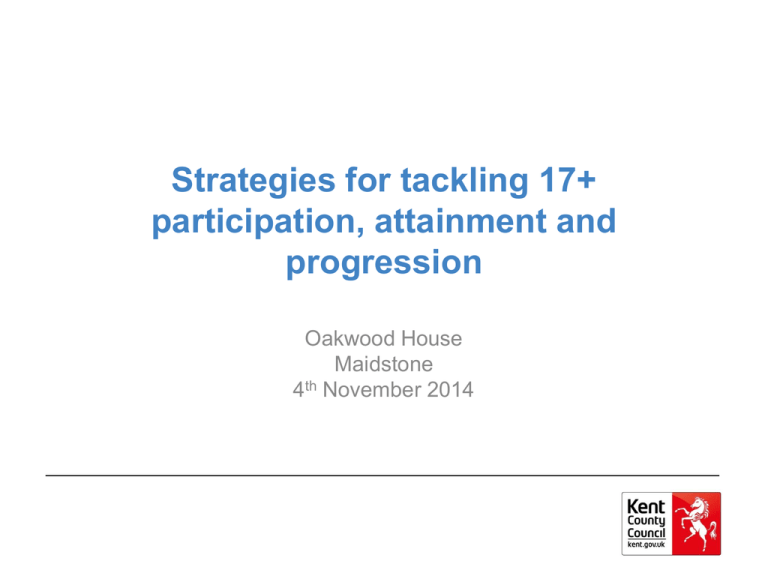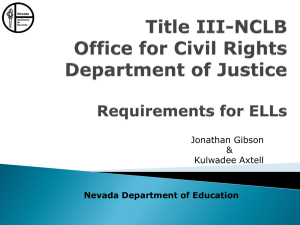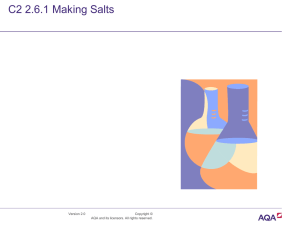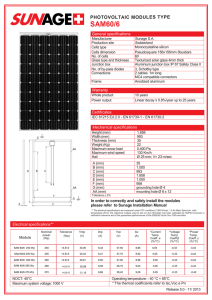Nov 4th master
advertisement

Strategies for tackling 17+ participation, attainment and progression Oakwood House Maidstone 4th November 2014 17+ participation, attainment and progression in London: Main research findings and recommendations Professors Ann Hodgson and Ken Spours Institute of Education, University of London The 17+ issue • RPA and the importance of sustained and high quality participation post-16 • Successful 17+ participation is the major indicator of potential success at L3 and progression from L2 to L3 by age 19 • London has made important strides in pre-16 attainment but less so in post-16 attainment at L3 • In 2013/14 IOE/London Councils have been researching this issue using secondary data and visits to schools and colleges 17+ participation • Participation at 16 &17 in 2014 in London is higher than the rest of the country (92.3%/90.8%) and in full-time education (88.7%/83.2%). Participation at 17 continues to rise • But under 3% of 16 &17 year olds are in WBL/Apprenticeship and this has continued to fall • Participation rates varied considerably between London boroughs depending on their level of economic and social deprivation. • The proportion of 16-18 year olds studying in school sixth forms and sixth form colleges (SFCs) has increased over the past year, while the percentage studying in general further education colleges (GFEs) has declined. 17+ retention • Only a third of school students embarking on a L2 course at 16 progressed to L3 study. • 17+ retention in A Level programmes in schools (82%) is greater than in L3 vocational programmes (59%). • Just under a quarter of Year 12 L3 starters ‘dropped out’ of their sixth form before 18. • GCSE English and maths at grades A*-C are highly important in 17+ retention as are the number of GCSEs or vocational equivalents (8 not 5) 17+ attainment • London is below the national average on all L3 attainment measures (except attainment of two L3 awards at 18) and notably on total points – 682 compared to 706 nationally • Broader attainment at KS4 produces better outcomes post16: About 30% of L3 learners in London schools in 2011/12 did not have A*-C grades in GCSE E&M and scored on average 540 points Those who had at least 5 GCSE A*-C grades including E&M scored on average 753 points at L3. Those with 8+ GCSE A*-C grades including E&M scored on average 795 points. 17+ participation, attainment & retention in Kent: a brief comparison Much higher than national average GCSE results (5 GCSE A*-C grades incl’ maths and English) Above national average in A Level per student scores – 818/796 but slightly below national average on other measures of A Level outcomes Enormous inter-institutional variation – 1600/252 – for scores per student Overall retention (78%) and transition retention (84%) looks about average or slightly above 17+ risk factors for schools 17+ risk factors for GFEs and SFCs School strategies at Key Stage 4 10 School strategies in Year 12 11 GFE and SFC strategies at 17+ 2. Tracking performance and organising individualised interventions 1. Tightening admissions criteria and offering alternative routes 3. Providing individual support and additional activities Supporting the 'vulnerable' advanced level learner Recommendations 1. The need for a pan-London focus on 17+ participation, attainment and progression 2. A Post-16 London Challenge focused around the 17+ issue • • • Addressing institutional and borough-based variation A step change in the sharing of good practice on the 17+ issue particularly on high quality A Level teaching and learning and underpinning support systems Raising performance through increased partnership working 1. Effective 14-19 Careers Education, Information Advice and Guidance 2. An emphasis on building in progression skills at KS4 3. Increasing the supply of high quality vocational (or mixed academic/vocational) L3 provision and apprenticeships 4. Developing planned ‘three-year sixth’ programmes and reinstating funding for 18 year olds Alps Advanced Level Performance Systems The Implications of Post 16 Reform Guiding your students safely through the rapidly changing Post-16 landscape from now to 2018 Kent LA November 2014 John Philip Outline of this session • A Level Reform – how best to prepare your school / college for September 2015 implementation • How and when are A Levels changing • Preparing your school or college for the linear A Levels • The implications for Information & Guidance and monitoring Alps Vision & Ethos Alps Not just a book of numbers A process not a product A culture that raises student and school achievement Basic principles An individual Everyone is: An Exception To be valued Behind each piece of data is a young person Challenging Times • In the rapidly changing landscape making decisions that have the interests of each student at heart will be crucial. • Decisions that you make now may have a huge impact on the future life choices of the students who enrol in the sixth form in Sept 2015 & subsequently. Why and when are A-Levels changing? Why are A-Levels changing? • In the Ofqual ‘Update on the Reforms Being Made to AS Qualifications and ALevels’ (April 2014) 4 reasons are cited: 1. There are too many resits; 2. Too many assessments disrupt teaching; 3. Too many assessments can have a negative effect on other subjects; 4. The modular system isn’t giving students a broad range of knowledge. 2015 - 17 • • • • • • • • • • • Linear A-Levels Sept 2015 English language English literature English language and literature The sciences (Bi; Ch; Ph) History Psychology Art and design Sociology Business studies Economics Computing These ones go linear from Sept 2015 for Y11 • • • • • • • • • Modular A-Levels Mathematics and further maths MFL and ancient languages Geography Religious studies Design and technology Drama Dance Music Physical education These ones go linear from Sept 2016 for Y10 Linear A-Levels from 2017 • All other A-Level subjects offered by the English boards will become linear too for teaching from September 2017 or will be withdrawn from being A-Levels. • The Ofqual Consultation Completing GCSE, AS and A level reform (4 June) suggested which subjects may be ‘discontinued’ and which ‘reformed’. As of 10 October no absolute decisions on the Ofqual website http://ofqual.gov.uk AS / A Level subjects Ofqual are proposing to discontinue (June 2014) Subject (proposed last award 2016) UK awards 2012 Related continuing subject(s) (for first teaching 2015 and first award 2016) Science in society Applied science Environmental studies Human biology Applied art & design Humanities Economics and business 942 5,141 2,370 3,995 645 N/A 2,890 Sciences Sciences Sciences Biology Art & design History; Geography (2017) Economics; Business studies Applied business 9,841 Business studies Home economics (food, nut. & health) 506 DT: food technology Engineering Performance studies Performing arts Subject (proposed last award 2017) Quantitative methods Use of mathematics DT: systems and control technology Dance; Drama and theatre studies Dance; Drama and theatre studies Related continuing subject(s) (for first teaching 2016 and first award 2017) Mathematics Mathematics These ones may not exist from Sept 2017 for Y9 N/A 1,220 1,873 UK awards 2012 2,998 One argument is that the subjects on the left are similar or overlapping with those in the column above AS / A subjects Ofqual are proposing to ‘reform’ (turn linear) for first teaching Sept 2017 (June 2014) Subject Accounting Anthropology Applied information and communication technology Archaeology Citizenship studies Classical civilisation Classics Communication and culture Creative writing Critical thinking Electronics Film studies General studies Geology Subject Government and politics Health and social care single award History of art Information and communication technology Law Leisure studies Media studies Media: communication and production Music technology Philosophy Statistics Travel and tourism World/global development These ones may go linear from Sept 2017 for Y9 Last award of unreformed AS Levels = 2018 (still exist for Y9 too) Standalone AS Levels • In March 2013 the Government decided that AS qualifications should be separated from A-Levels, making them completely freestanding. • Separating them means students will be able to take new ALevels without also taking an AS in the subject (if students take an A-Level after doing the AS, they’ll be reassessed on the material they’ve covered). • The challenge of the new AS qualifications will be the same as now. They will be assessed at the same level of demand as they are now. • Exam boards are able to design AS qualifications so schools and colleges can (if they want) teach them alongside the first year of the A-Level in that subject. Why ignore them? • Cost might drive the decision. After all doing these exams is not compulsory. • University may not use the results for offers if they are not ‘universal’. • Will enable teachers to spend two years teaching towards the skills required for success in the harder A-Level papers without being distracted by the demands of the AS. Why use them? • Will you be risking students spending 2 years on A-Level courses and failing if you don’t enter them for AS in Y12? • How accurate are your current teacher progress grades? Can you rely on their professional judgement alone to guide your assessment of student progress? • Universities may use the results for offers even if they are not ‘universal’. Core Maths • “The government has set out an ambition for the overwhelming majority of young people in England to study mathematics at least to age 18 by 2020. We lag behind our competitors internationally both in the proportion of students studying maths to age 18 and in the proportion studying the subject to advanced levels, yet these skills are increasingly essential to higher education study, young people’s future careers and the economy more generally.” DfE Jan 2014 Core Maths • Core Maths qualifications should be designed to be taken over two years. These new qualifications will be around half the size of an A-Level. • Core Maths content should focus on: 1. the application of mathematical knowledge to address problems and questions; 2. representing situations mathematically; and 3. use of mathematical and statistical knowledge to make logical and reasoned arguments in a variety of contexts. • Core Maths will be available for first teaching in September 2015 and is not currently a statutory requirement. • The DfE is piloting Core Maths from September 2014. Timeline From AQA website General Election 2015 • On Monday 11 August Labour announced that they would put on hold all A-level reforms due to be introduced next year and scrap the central plan to abolish AS-levels. • However there are at least two unknowns: • Will Labour win the 2015 General Election? • Will it be possible to make changes to the reforms before September 2015 (given the time and money Exam Boards have put into developing specifications, specimen papers and actual papers for the new reformed A Levels)? • In our view it would be unwise to assume there is no need to plan for the linear A Levels. Preparing your school / college for the new A-Levels Engaging with staff, students and parents to ensure a smooth transition Sixth Form Brochure • Perhaps entries for the linear subjects (from Sept. 2015) should all be grouped together at the front of the brochure; • Perhaps follow with those that will then become linear in Sept. 2016: then all other A Levels, then other L3 qualifications then GCSEs • The brochure could explain that more precise subject guidance for the linear subjects will be issued when available. New Linear Specifications for Sept. 2015 • In theory the exam boards were to have these available from September 2014 (this has slipped for some specifications*). • Having discussions with subject leaders about their criteria for choosing one might help • • • • Content Assessment objectives Specimen papers Co-teachable AS (unless you don’t intend to use Standalone ASs) * As of 10 October Art & Design AS – 1 out of 4 specifications accredited AQA A level – 1 out of 4 specifications accredited AQA Biology AS – 3 out of 6 specifications accredited AQA OCR A OCR B A level – 3 out of 6 specifications accredited AQA OCR A OCR B Business AS – 3 out of 4 specifications accredited AQA OCR Pearson A level – 3 out of 4 specifications accredited AQA OCR Pearson Chemistry AS – 0 out of 5 specifications accredited A Level – 0 out of 5 specifications accredited Computer Science AS – 1 out of 3 specifications accredited AQA A level – 1 out of 3 specifications accredited AQA Economics AS – 5 out of 5 specifications accredited AQA Pearson A Pearson B WJEC Eduqas OCR A level – 5 out of 5 specifications accredited AQA Pearson A Pearson B WJEC Eduqas OCR English Language AS – 3 out of 4 specifications accredited AQA OCR Pearson A level – 3 out of 4 specifications accredited AQA OCR Pearson English Language and Literature AS – 2 out of 4 specifications accredited AQA OCR A level – 2 out of 4 specifications accredited AQA OCR English Literature AS – 1 out of 5 specifications accredited OCR A level – 1 out of 5 specifications accredited OCR Approved specifications 16 Oct 2014 History AS – 1 out of 4 specifications accredited Pearson OCR A level – 2 out of 4 specifications accredited Pearson OCR Psychology AS – 1 out of 4 specifications accredited AQA A Level – 1 out of 4 specifications accredited AQA Physics AS – 4 out of 5 specifications accredited AQA OCR A OCR B Pearson A level – 4 out of 5 specifications accredited AQA OCR A OCR B Pearson Sociology AS – 3 out of 3 specifications accredited AQA OCR WJEC Eduqas A level – 3 out of 3 specifications accredited AQA OCR WJEC Eduqas Check HoDs are getting prepared • Make sure HoDs have made an informed choice of specification – not simply stuck with the ‘devil they know’. • Then set some deadlines for the preparation of materials: • Scheme of work (will it include co-teachable AS?) • Other key resources – are new textbooks required (or desired)? • Student facing materials such as Learning checklists / content guides to enable them to understand the course. Learning checklist exemplar Week Topic Area Key Ideas 1 1) Introduction to Economics 2) The economic problem 3) Scarcity and choice 2 4) Economic resources 5) Production possibility diagrams The nature and purpose of economic activity, positive and normative statements Needs and wants, economic welfare, production and consumption The allocation of scarce resources, incentives, the environment, opportunity cost Land, labour, capital and enterprise, the factors of production Production possibility frontiers, opportunity cost, spare capacity RAG rate Green Topic understood, learned and applied in my work Amber Topic understood in class but I have had difficulty applying what I learned when tested Red Either •I was absent for some or all of this topic or •I did not understand this topic Learning checklist exemplar History: Assessing the importance of turning points (Synoptic unit) Can and use themes or criteria to assess the importance of the named turning point in the question Can identify other turning points during the hundred year period that are relevant to the key issue in the question and use themes or criteria to assess their importance Can compare, using themes or criteria, the relative importance of the named turning point and other selected turning points Compares the relative importance of at least two turning points in each paragraph using themes or criteria Compares the relative importance of at least two turning points in most sentences using themes or criteria Key B grade A* quality BTEC Changing too BTEC Assessment Rules from Sept. 2014 • ‘Assessors should move the focus of their feedback away from achieving specific grades and onto how learners can learn and progress’ Edexcel: Guide to Internal Assessment June 2014 Impact on BTEC Provision • Setting high aspirations in class by a clear focus on ensuring students understand how to meet Distinction* / Distinction criteria (or at least Merit) before they start each assignment is now critically important. Vocational Qualifications 2016-18 • The DfE is reforming post-16 Level 3 vocational qualifications in a similar way to that seen at Key Stage 4. • The proposal divides Level 3 vocational qualifications into two types: applied and technical. A list of the Applied qualifications that meet the interim requirements and can be counted in the 2016 tables was updated in April 2014. A list of the Technical qualifications that meet the interim requirements and can be counted in the 2016 tables was updated in May 2014. • These lists will be updated annually and by autumn 2015 they will publish the list of Level 3 qualifications that meet the new requirements (including a strong emphasis on synoptic and external assessment). • These new qualifications will be first taught in September 2016 and will be reported in the 2018 tables. Information and Guidance Information and Guidance In terms of recruitment of current Year 11 for September 2015 start thinking about: 1. Which students would cope best with linear A-Levels (as some A-Levels will still have modular AS units up to May 2017)? 2. Will teaching need to change to support the full range of learners on linear courses? 3. Whether students on the linear pathway would take 3 or 4 A-Levels in Y12 (with many dropping to their chosen / best 3 in Y13 based on mocks / teacher assessment / stand alone AS results)? 4. Whether to enter students on the linear A-Levels for stand-alone AS exams in the summer of Y12? Study Programmes • Ofsted published ‘Transforming 16 to 19 education and training: the early implementation of 16 to 19 study programmes’ in September 2014. • In it they state that ‘school and academy leaders interviewed were unaware of the full extent of the requirements of the study programmes and the implications for their sixth form provision. Implementation was generally too slow in these types of institutions’. • The key requirements of study programmes are that they should: • • • • be individualised and provide progression to a higher level of study than learners’ prior attainment to meet clear educational and career aspirations include qualification(s) that stretch the learner and link clearly to progression routes to training, employment or higher education, or include an extended period of workexperience/work preparation for those learners who are not ready to study for a substantial qualification at level 2, or a traineeship include continued teaching, to enable learners to work towards achieving English and mathematics GCSE grades A* to C, for those who do not already hold these, or other interim/stepping stone qualifications towards achieving these GCSEs allow for meaningful work experience (related to the vocational area) or other nonqualification activity to develop learners’ personal skills and/or prepare them for employment, training or higher/further education. Get Your Curriculum Right for all Students • ‘A common feature of less effective sixth forms is a poor match between the curriculum and students’ abilities. This is sometimes exacerbated by weaknesses in information, advice and guidance, particularly when students are directed to courses which are inappropriate for their needs and capabilities.’ • Annual Report of Her Majesty’s Chief Inspector of Education, Children’s Services and Skills Strategic Decision - 1 • In our view school / college leaders need to make strategic decisions about how they will deal with some of the issues: Will teaching need to change to support the full range of learners on linear courses? Will all sixth formers be equally suited to the demands of linear assessment? 3 or 4 AS / A-Levels in Y12 • A tough decision – clearly it will cost more in terms of teaching to put them on 4 AS rather than 3 – but will they be fully funded students? • How confident will you be in allowing current Y11 to choose 3 linear subjects? • And what about the students who want to do some subjects that retain the current ‘counting’ AS 2015-17 alongside some that are linear? Strategic Decision - 2 • In our view school / college leaders need to make strategic decisions about how they will deal with some of the issues: Will Y12 students start with 4AS/A Level subjects as at present or will they start with 3 as was common prior to Curriculum 2000? Recruiting Students: An Example • You are interviewing me for a place in your Sixth Form from September 2015; • After a discussion about post-18 ambitions and current GCSE predictions I ask if I can take: • Biology (linear) • Geography • Mathematics • Psychology (linear) All sorts of issues • Should I be allowed 4 or limited to 3? • How many hours will I be taught per week per subject and will I be a full-time student on 3? • Will I be doing AS in Geography and Maths but not ‘standalones’ in Biology and Psychology? • If so, which subjects will I work hard in during Y12? • How will you (and / or I judge which subject to discontinue in Y13)? • Will my ‘core aims’ in the October census be AS in 2016 or A-Level in 2017? Current AS Results • Although most students who complete Y13 pass A-Levels, the A-E pass rate at AS has been around 87% for some time; • In most schools the grade Us are not equally shared across all subjects; • Success rates at AS based on starters – those who were on AS courses in October is even lower – 75.5% in 2013. • They are especially low in some subjects such as Psychology. IAG at the end of Y12 • In 2016 you will have AS results for subjects that are still modular. • You will not have AS results for the first group of linear A Levels (unless taking the ‘standalones’). • The following exercise models the Student Performance Report for a school where students have not sat standalone AS exams. • Have a careful look and consider which students could not progress to Y13 and which students it would prove difficult to help them decide which subjects to continue to A Level. To Stand Alone .... or not? • Unless you teach in a school with exclusively able students (and teachers) you might consider retaining the 4AS / 3A structure at least for the first two ‘guinea pig’ years (2015-17 & 2016-18) and entering students for all AS whether standalone or ‘counting’ as many / most students may well be on a mix of courses. • We certainly think that any more marginal Sixth Formers need to be on an AS pathway regardless of whether they are on linear or ‘still modular’ A Levels (and possibly limiting their choice of linear A Levels to a maximum of 2) simply to ensure that if things go wrong they leave at the end of Y12 with something. Strategic Decision - 3 • In our view school leaders need to make strategic decisions about how they will deal with some of the issues: Will the school use stand alone ASs (at least for 2016 and 2017)? The implications for students in lower years • Y10 will be the first GCSE cohort measured against the ‘Progress 8’ accountability framework in 2016. • They will then start A Levels in September 2016 with many more becoming linear for them. • Y9 will take new-style GCSEs in English and maths (graded 1-9)to be taught from Sept 2015 • Y9 will then start exclusively LINEAR A Levels in September 2017. • All GCSEs for current Y8 will be linear (graded 1-9) as will be all A Levels. Strategic Decision - 4 • In our view school leaders need to make strategic decisions about how they will deal with some of the issues: What preparation needs to be done between now and September 2017 to develop greater independence and resilience with students in younger year groups? CPD / Training Training Issues • Any teachers who started Sixth Form in September 2000 (or later) have no experience of linear A-Levels even as a Sixth Form student. • How best to prepare staff for teaching more challenging content? • How best to ensure staff are able to assess progress accurately? A post-16 Linear A-Levels focus group • The introduction of a Sixth Form Teaching and Learning group can provide schools with a positive forum for discussing effective teaching, learning and assessment of Sixth Form students. • In the early years of the new millennium I ran such a group. In our first year we met once each half term with a single agenda item: What does outstanding teaching and learning in the Sixth Form look like? • This would be a good idea for any school / college in the new and challenging educational landscape. Get representatives of your AS/A-Level departments together to discuss how to structure, teach and assess linear A-Levels. Lessons that have pace, rigour and, if possible, thrill: the joy of learning / discovery / accomplishment Lessons that have clear objectives and an overt link to the examination / assessment requirements An effective scheme of work for teachers and students to follow If the 3 part lesson is a good idea at KS3 and KS4, what about KS5? Outside the Box / Classroom Students able and willing to extend their learning beyond the classroom, reinforcing skills and knowledge learnt in lessons. Development of Website to give the students the ability to access our classrooms at home. Practice Testing Working through past questions Regular reinforcement of key learning objectives; testing from an early point (before half-term in first term in Y12) Modelling of good answers; examples written by teacher or student. Use of relevant sections of mark schemes and Examiner’s Reports Clear outline of unit and its assessment requirements: the ‘road map’: to include feedback to students from Exam Reports / Exam board meetings Support in place for those who require more help Teacher Well-organised Positive Confident Helpful Approachable Good relationships between students and the teacher. Teacher aims to treat students as adults, expecting in turn an adult response / approach. Students understand the AS / A-Level system, e.g. the relationship between AS and A and the importance of UMS marks. Regular feedback (e.g. through marking and individual discussion) that enables the individual student to target improvements in the standard of his or her work by understanding how this can be done. Students increasingly encouraged and able to take responsibility for their own learning: professional students. Students developing into independent learners. Assessing the New A-Levels Assessing the new A-Levels • In general there has been a conscious decision to reduce or eradicate teacher assessment from the new linear A Levels. Assessing the new A-Levels (2015-2017) English language 2015 Exams – 80% English literature Non-exam assessment – 20% 2015 Exams – 80% English language and literature Non-exam assessment – 20% 2015 Exams – 80% Biology Non-exam assessment – 20% 2015 Exams – 100% Chemistry A separate assessment for practical skills 2015 Exams – 100% Physics A separate assessment for practical skills 2015 Exams – 100% Psychology A separate assessment for practical skills 2015 Exams – 100% Art and design 2015 Non-exam assessment – 100% Business studies 40% is allocated to tasks set by exam boards and completed in a specified time 2015 Exams – 100% Computer science 2015 Exams – 80% Economics Non-exam assessment – 20% 2015 Exams – 100% History 2015 Exams – 80% Sociology Non-exam assessment – 20% 2015 Exams – 100 Students will either pass or fail the practical skills assessment Students will either pass or fail the practical skills assessment Students will either pass or fail the practical skills assessment Introduced to improve consistency across exam boards and specifications Assessing the new A-Levels (2016-2018) The Ofqual consultation on the assessment of these A Levels finished on 22 September 2014. The outcomes have not been announced as of 10 October 2014. Assessing the new A-Levels (2016-2018) The Ofqual consultation on the assessment of these A Levels was launched in September 2014. The closing date for responses is Monday, 19th November 2014. 6 The A level and AS qualification are titled ‘Drama and theatre’. Linear A-Levels (2016-18) Summary of current proposals • The current proposals are: • the continued but reduced use of non-exam assessment in dance, music and physical education at GCSE and A level and in modern foreign language A levels • 60% non-exam assessment in AS & A Level Drama and theatre • the reintroduction of the assessment of fieldwork to A level geography • exam only assessment in A level mathematics and further mathematics Tracking and Monitoring Student Progress An assessment issue • With linear A-Levels accurate in year assessment will become critical for students and schools / colleges; • Thinking through when assessments / mock exams are scheduled (and how many should happen each year) needs doing sooner rather than later. Strategic Decision - 5 • In our view school leaders need to make strategic decisions about how they will deal with some of the issues: What will the Sixth Form monitoring and assessment calendar look like from September 2015? Recording student data Several issues to consider • How often do you want teachers to record fresh student data? • What grades do you want them to record? • How can you make sure both teachers involved if subject taught by 2 teachers? • What grade criteria do you want them to use? • How can you ensure they do? Clear definitions • Minimum target grade • A statistical starting point NOT a ceiling • Student individual target grade • A professional judgement of their potential • Progress grade • A professional judgement of their outcome based on current evidence • Effort or attitude to learning grade So what is a progress grade? Based on their current work and all available evidence, the most realistic grade you think the student will achieve in their AS /A / BTEC if they do not change their current working habits and standards Consequences of inaccurate student progress grades • Incorrect students are identified for intervention • Students apply for inappropriate university courses • School/college resources are targeted in the wrong curriculum areas • Outcomes in the summer come as a surprise • With linear courses, accurate teacher assessment mid-course will be essential Some teachers tell SLT and / or what they think they want to hear? Multi-faceted monitoring Monitoring all aspects of data helps tell the student’s story and will ensure that there are no surprises when it comes to Results Day • Attendance by student, by subject, by teacher, by month • Punctuality (as above) – consistency is needed • High grade/pass rate performance by subject, by teacher, by paper, by module, by coursework, by Faculty, by school • Value added performance (as above) • Retention rates throughout the year • Progression numbers from AS to A2 by subject The importance of monitoring attendance Recent research confirmed the following: • If you compare students of equal ‘ability’ – those with attendance of over 95% perform one grade higher per subject than those with attendance of 85% or less • Each further 10% fall reduces this by another grade N.B. One week’s holiday per year during term time = a 3% fall in attendance. Tell the students and their parents this is the reason why holidays will never be authorised during term time. An attitude to learning grade 4. Outstanding attitude to learning. Takes personal responsibility for his / her own learning; always ready to learn. 3. A positive attitude to learning; working hard to improve the quality of his/her work and usually ready to learn. 2. An inconsistent attitude to learning, requiring an improvement in this subject; sometimes ready to learn. 1. A poor attitude to learning and a cause for concern; rarely ready to learn. Encourage teachers to enter Y in mark sheets to indicate specific concerns (such as coursework) and to recommend for special praise Alps Monitoring Reports Alps Monitoring Reports • Taking value added to a new level. • ‘If students achieved these monitoring/progress grades at the end of their course what would the value added performance of our students and the institution be?’ • Formative rather than summative Alps Reports. Alps Monitoring Reports • May become a crucial progress indicator for all schools with the onset of linear A Levels • Accurate teacher assessments will be absolutely crucial for schools and colleges however. Post-16 Accountability Ofsted • The re-introduction of the Sixth Form Grade in September 2014 brings an even sharper focus on sixth form provision in schools. When is Post-16 accountability changing? • It is changing radically in 2016; • In 2017 you will receive your first linear ALevel results so essentially there is a ‘double whammy’. How the students are being assessed is altering radically and so is how your school / college is assessed post-16. Accountability – Headline Measures from 2016 •Progress between key stage 4 and graded level 3 qualifications, expressed as a proportion of a grade above or below the national average level and a combined attainment/completion measure. Minimum floor standards will be set based on PROGRESS. •Attainment data for each type of qualification • Level 3 academic qualifications an A-Level style grade, e.g. C- or B+. • Applied General qualifications, Tech Levels and substantial vocational qualifications at level 2 a vocational grade, e.g. D- or M+ •English and Maths GCSE – for students without at least a grade C at 16 •Retention - show the proportion of students who are retained by a provider and complete the ‘core aim’ (for academic programmes this typically means at least one A-Level (or equivalent); for vocational programmes this means the substantive vocational qualification representing at least half a study programme) •Destinations - showing the percentage of students progressing to sustained education, employment or training, including data at local authority level, so that destinations for students in the same area can be compared. Vocational Exemplar •This diagram gives an indication of how the headline measures could look on a school or college’s website. It shows progress and attainment for Tech Level qualifications, but users would be able to switch from the default view to show results for academic qualifications, Applied General and level 2 substantial vocational qualifications. Minimum Standards • New, more rigorous minimum standards will replace the current interim standards from 2016. • Minimum standards will be set separately for academic, Applied General, Tech Level and substantial vocational qualifications at level 2. • Not meeting the minimum standard in any one of these categories would identify the provider as underperforming. • For level 3 Academic and Applied General qualifications, minimum standards will be based on the Value Added progress measure. John Philip Please ring or e-mail anytime with questions or issues on T & L, target setting, Alps indicators, training etc... You can contact me via training@alps-va.co.uk 01484 887600








